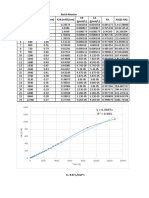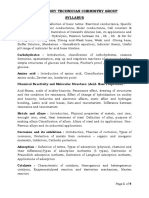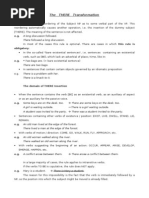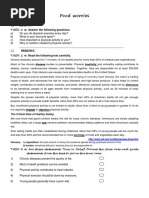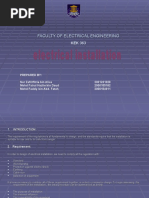Humic Substances Removal From Drinking Water by Membrane Filtration
Humic Substances Removal From Drinking Water by Membrane Filtration
Uploaded by
Mayursinh SolankiCopyright:
Available Formats
Humic Substances Removal From Drinking Water by Membrane Filtration
Humic Substances Removal From Drinking Water by Membrane Filtration
Uploaded by
Mayursinh SolankiOriginal Description:
Original Title
Copyright
Available Formats
Share this document
Did you find this document useful?
Is this content inappropriate?
Copyright:
Available Formats
Humic Substances Removal From Drinking Water by Membrane Filtration
Humic Substances Removal From Drinking Water by Membrane Filtration
Uploaded by
Mayursinh SolankiCopyright:
Available Formats
Desalination
ELSEVIER
145 (2002) 333-337
Humic substances removal from drinking water
by membrane filtration
Zoltan Domanya, Ildiko Galambosb, Gyula Vataib*, Erika Bekassy-Molnarb
A.D. Fermin -Yeast-Factory, Senta, Yugoslavia
Scent Istvan UniversiQ, Faculty of Food Science, Department of Food Engineering,
1118 Budapest, MLnesi tit 44., Hungary
Tel. +36 (1) 372-6232; e-mail: gvatai@omega.kee.hu
Received
1 February 2002; accepted 25 March 2002
Abstract
In this study the removal of humic substances from model-solution and well-water using four different ultrafiltration
membranes has been investigated. The permeates were analysed by UV254nmabsorbance, TOC and DOC measurements.
Based on our experiments it can be established that the examined membranes are suitable for the humic acid removal.
The removal efficiency of all investigated membranes was relatively high (~90%) in case of model-solutions.
The
rejection of the membranes in case of natural well-water was lower (=60-70%) due to different composition of the
humics.
Keywords: Humic substances;
Drinking water; Ultrafiltration;
1. Introduction
The drinking water treatment has an increasing
attention because of the strict regulations of the
drinking water quality and the contamination of
the drinking water sources. The problem of humic
substances in water has been focused on the basis
of the new research results in the water quality
measurements. It is proved, that some carcinogenic
*Corresponding author.
Presented at the International
7-12, 2002.
Congress on Membranes
Membrane
screening
substances are the by-products of the reactions
between the water clarifying antiseptics and the
dissolved organic substances, and this secondary
products have negative effect on the health of
people in a long-term period [ 11.
The picture created about humic substances
is still mysterious and full of inconsistencies,
because this name defines a group of very heterogeneous structured organic macromolecules
[2].
The humic substances are coloured from yellowish
and Membrane
Processes
JLIIJ
001 l-9164/02/$-
See front matter 0 2002 Elsevier Science B.V. All rights reserved
PII:SOOll-9164(02)00432-O
(ICOM),
Toulouse, France,
334
Z. Domany et al. /Desalination
to dark brown, faintly acidic macromolecular conglomerations. Their structure can not be classified
without destructive processes, that is the reason
why it is very difficult to determine the exact
physical and chemical characteristics.
Some
humic substance fractions are soluble in water,
but there are fractions, which are present as
colloidal
solutions.
They can be classified
according to their solubility and molecular weight:
a.) fulvic acids: with average molecular weight
12000 Da, the average length of the macromolecules is 60 nm, the average diameter is
2 nm. These substances are generally soluble
in water.
b) humic acids: their average molecular weight
is 2000-5000 Da, in their chemical structure
dominate the phenol-groups, the long carboncyclic fatty acids, etc. These macromolecules
are more hydrophobic in comparison with the
fulvic acids.
humics: they build that fraction of humic substances, which do not dissolve neither in bases
nor in acids. They can be fractionated with
methyl-isobuthyl-keton.
It is determined, that
the humics consist of bitumen, coupled with
fatty acids and humic acids. The composition
of the humic substances are defined always
the place of the huminification (the organic
composition of the soil) [3-4].
c>
On the basis of literature data [3] and the average
molecular weight of the substances the ultrafiltration membranes with or without additives
145 (2002) 333-337
(powdered activated carbon - PAC, flocculent)
are suitable for humic substance removal.
2. Materials and methods
In our experimental investigations the feed
solutions were as follows:
l
deionized water,
l
humic acid model-solution: commercial humic
acid product of the Sigma-Aldrich GmbH.,
Germany, was dissolved in deionized water,
for membrane screening purposes
l
well-water from Senta, Yugoslavia .
DDS 20 Minilab laboratory apparatus in crossflow mode was used for membrane screening.
Four different ultrafiltrations membranes were
tested with nominal molecular weight cut-off
(NMWCO) of 5 kDa, 6 kDa, 15 kDa and 100 kDa,
respectively. The characteristics of investigated
membranes are shown in Table 1.
3. Results and discussion
First we have tested the 4 different membranes
by measuring the flux of the deonized water,
model-solution and well-water. Experiments were
carried out at constant temperature: t = 25*1C,
the recycle flow-rate (Q,) was varied between
260400 L/m*h .
The diagram in Fig. 1 shows, that the 4 membranes (with the smallest MWCO value) had the
lowest fluxes with all investigated feed solutions.
Table 1
The characteristics of investigated membranes
Membrane
Typeandcode
Producer
Material
NMWCO
kDa
Pure water flux*
L/m2h
BFM-70 lOO-Ml
SP 015 A-M2
SP 006 A-M3
BFM-3705-M4
Berghof
Mavibran
Mavibran
Berghof
Polyether-sulfon (PES)
Polyether-sulfon (PES)
Polyether-sulfon (PES)
Poly-aril-ether-ketone(PAES)
100
15
6
5
222.2
213.6
191.5
76.1
*at 25C and 4 bar
Z. Domany et al. /Desalination
335
145 (2002) 333-337
250
200
50
deiomzed water
0
0
4
AP
(bar)
Fig. I. Comparison of the membrane fluxes with different
feed solutions (Ap = 4 bar, QR= 260 L/h).
Fig. 2. Influence of the transmembrane pressure on permeate
flux with model-solution at constant temperature (t = 25C)
and recirculation flowrate (Q, = 260 L/h).
The next diagram in Fig. 2 shows the influence
of the transmembrane pressure on permeate flux
of the model-solution. (The recirculation flow-rate
was constant: 260 L/h.)
The concentration of organic substances in the
feed, permeate and retentate were determined by
measuring the absorbance on UV254nm.Also the
dissolved organic carbon (DOC, [mg/L]) and the
total organic carbon (TOC, [mg/L]) were analysed.
The comparison of the humic acid concentration
in the permeate using different measurement
techniques is shown in Fig. 3.
From the diagram it is obvious that the permeate
concentrations are almost one order of magnitude
lower than the feed concentrations in case of all
membranes measured with different measurement
techniques (UV absorbance, TOC, DOC), with
means that the humics and organics rejection of
the membranes is high.
The humic acid rejection of the membranes
on the basis of TOC, DOC and absorbance measurements were calculated. The comparison of rejections
calculated on the basis of different concentration
measurements is shown in Fig. 4.
/q-------
...-.-.
_._._.._..__,__
oz
ml
Fig. 3. Humic acid concentrations in the permeate measured
with UV absorbance, DOC and TOC.
Fig. 4. Humic acid rejection of different membranes.
336
Z. Domany et al. /Desalination
From the diagram it can be concluded that the
DOC rejection of the membranes was approximately
70% which influenced the lower TOC rejection.
The rejection measured by UV absorbance was
satisfactorily high (~90%) with all membranes.
The following diagram in Fig. 5 represents the
variation of the TOC, DOC and the humic substances concentration in the permeate with the
membrane pore size NMWCO. The concentrations are already constant with membranes around
20 kDa which means that in this region there are
no influence of membrane pore size (NMWCO)
on permeate concentration (UV abs., DOC, TOC).
In Fig. 6 the humic acid concentrations estimated
on the basis of UV254nmabsorbance measurements
in different feed-waters: model-solution and wellwater from Senta (district of Vojvodina, Yugoslavia), and the UF permeates of above feed
waters are compered. From this comparison it is
obvious, that the humic acid concentrations (UV2._,
abs. measurement) in well-water and well-water
permeate are higher than in the model-solutions.
The humic substances rejections calculated
from this results are ~90% in model sulutions and
between 62-69% in case of well-water. These
results correspond to Schafer, Fane and Waites
measurements
[5]. This phenomenon could be
explained with different composition or molecular
weight distribution of different sources, which has
been established by Lin and Huang, as well [3].
145 (2002) 333-337
fDOC
10
NMWCO (kOa)
Fig. 5. TOC, DOC and Abs concentration depending on
the NMWCO (Q, = 400 L/h, Ap = 4 bar).
Fig. 6. Concentration from absorbance (Q, = 260 L/h).
by using membranes with lower pore size; i.e. UF
membranes with lower NMWCO or nanofiltration
membranes (NF).
4. Conclusions
Acknowledgements
Based on our experiments it can be established
that the examined membranes are suitable for the
removal of humic substances. The removal efficiency (rejection) of all investigated membranes is
high enough (85-90%) in case of model-solutions.
The rejection of the membranes in case of natural
well-water was lower (62-69%), as well as the
permeate concentrations were still high (=4 mg/L).
The removal efficiency should be improved by
adding some additives (flocculant, adsorbant) or
This study was financial supported by the OTKA
Foundation (T26140).
References
[l]
[2]
Ci (%lcis, Water clarification - and operation, Egri
Nyomda Kft., 1998 (in Hungarian).
C.-F. Lin, Y.-J. Huang and 0. J. Hao, Ultrafiltration
processes for removing humic substances: effect of
molecular weight fractions and PAC treatment, Wat.
Res., 33 (1999) 1252-1264.
Z. Domany et al. /Desalination
[3] K. Scott, Handbook of Industrial Membranes. Elsevier
Advanced Technology, Oxford, UK, 1995.
[4] M. Alborzfar, G. Jonsson and C. Grgn, Removal of
natural organic matter from two types of humic ground
145 (2002) 333-337
[5]
337
waters by nanofiltration, Wat. Res., 32 (1998) 29832994.
AI. Schafer, A.Ci Fane andT.D. Waite, Fouling effects
on rejection in the membrane filtration of natural
waters, Desalination, 13 1 (2000) 215-224.
You might also like
- CH 12Document11 pagesCH 12chaitanyacheggNo ratings yet
- Nadeem Hasnain - Indian Society and Culture Xaam - inDocument315 pagesNadeem Hasnain - Indian Society and Culture Xaam - inSikha40% (5)
- Combination of Physico-Chemical Treatment and Nanofiltration To Reuse Wastewater of A Printing, Dyeing and Finishing Textile IndustryDocument8 pagesCombination of Physico-Chemical Treatment and Nanofiltration To Reuse Wastewater of A Printing, Dyeing and Finishing Textile IndustrywaqaskhanNo ratings yet
- Combination of Physico-Chemical Treatment and Nanofiltration To Reuse Wastewater of A Printing, Dyeing and Finishing Textile IndustryDocument8 pagesCombination of Physico-Chemical Treatment and Nanofiltration To Reuse Wastewater of A Printing, Dyeing and Finishing Textile IndustryChittaranjan SahooNo ratings yet
- Amorphous Cellulose - Structure and CharacterizationDocument9 pagesAmorphous Cellulose - Structure and CharacterizationzksaraNo ratings yet
- 0851 0859 PDFDocument9 pages0851 0859 PDFnagatopein6No ratings yet
- Synthesis and Characterization of Low Molecular Weight Cut Off Ultrafiltration Membranes From Cellulose Propionate PolymerDocument10 pagesSynthesis and Characterization of Low Molecular Weight Cut Off Ultrafiltration Membranes From Cellulose Propionate PolymerGokul VenugopalNo ratings yet
- Hòa Tan CelluloseDocument11 pagesHòa Tan Cellulosehoclee2003No ratings yet
- Chang 2012Document9 pagesChang 2012Lintang Noor FitriaNo ratings yet
- Articol EdtaDocument7 pagesArticol EdtaCami BratuNo ratings yet
- Optimizing The Coagulant Dose To Control Membrane Fouling in Combined Coagulation Ultrafiltration Systems For Textile Wastewater ReclamationDocument7 pagesOptimizing The Coagulant Dose To Control Membrane Fouling in Combined Coagulation Ultrafiltration Systems For Textile Wastewater ReclamationAngga SaputraNo ratings yet
- Manson2011 Article PolyethyleneGlycolFunctionaliz PDFDocument7 pagesManson2011 Article PolyethyleneGlycolFunctionaliz PDFVaswati BiswasNo ratings yet
- CoagulationDocument15 pagesCoagulationlinhmungNo ratings yet
- Transport Coefficients and Cadmium Salt Rejection in Nanofiltration MembraneDocument8 pagesTransport Coefficients and Cadmium Salt Rejection in Nanofiltration Membraneعبدالوهاب الغماريNo ratings yet
- Dec10 16 PDFDocument8 pagesDec10 16 PDFijasrjournalNo ratings yet
- Dec10 16 PDFDocument8 pagesDec10 16 PDFijasrjournalNo ratings yet
- Vol-1, Issue-5Document13 pagesVol-1, Issue-5Ijrei JournalNo ratings yet
- Ultrafiltration of Aqueous Solutions Containing DextranDocument11 pagesUltrafiltration of Aqueous Solutions Containing DextranJulio TovarNo ratings yet
- Membrane Hybrid Processes in Water Treatment - The State of ArtDocument7 pagesMembrane Hybrid Processes in Water Treatment - The State of ArtCeci SitohangNo ratings yet
- Limitations in CelluloseDocument6 pagesLimitations in CelluloseShofiaNo ratings yet
- Silicalite - 1 Zeolite Membranes For Co Separation: Margaret E. Welk, François Bonhomme, Tina M. NenoffDocument2 pagesSilicalite - 1 Zeolite Membranes For Co Separation: Margaret E. Welk, François Bonhomme, Tina M. NenoffRebeca LópezNo ratings yet
- Autopsy of Membranes..... 12Document27 pagesAutopsy of Membranes..... 12Pendi Adi MertaNo ratings yet
- Cellulose Nanofibers Prepared by Tempo-Mediated Oxidation Under Acid Conditions Saito, T., Fukuzumi H., Hirota M., Isogai, ADocument2 pagesCellulose Nanofibers Prepared by Tempo-Mediated Oxidation Under Acid Conditions Saito, T., Fukuzumi H., Hirota M., Isogai, Aijovis83No ratings yet
- J Desal 2007 10 046Document7 pagesJ Desal 2007 10 046sunil3srpNo ratings yet
- G Nanou 2005 PolymerDocument9 pagesG Nanou 2005 PolymerAaronZhuNo ratings yet
- Water Desalination Using Ceramic Membrane DistillationDocument6 pagesWater Desalination Using Ceramic Membrane DistillationErwin FernandezNo ratings yet
- C Thang C VenDocument10 pagesC Thang C VenAditya RahmatNo ratings yet
- 1991 Volatiles en Sedimentos Por Headspace DinamicoDocument38 pages1991 Volatiles en Sedimentos Por Headspace DinamicoLuis VilchezNo ratings yet
- Superabsorbent Hydrogels Based On Cellulose For Smart Swelling and Controllable DeliveryDocument9 pagesSuperabsorbent Hydrogels Based On Cellulose For Smart Swelling and Controllable DeliveryDaniel MuñozNo ratings yet
- Membrane SeparationDocument22 pagesMembrane SeparationaidaNo ratings yet
- EnE 215 Examination SubmissionDocument7 pagesEnE 215 Examination SubmissionRicleto EspinosaNo ratings yet
- The Chemical Cleaning of Polymeric UF Membranes Fouled With Spent Sulphite Liquor Over Multiple Operational CyclesDocument13 pagesThe Chemical Cleaning of Polymeric UF Membranes Fouled With Spent Sulphite Liquor Over Multiple Operational Cyclesquangvlog017No ratings yet
- Application of Ceramic Membrane As A Pretreatment Digestion of Alcohol-Distillery Wastes in AnaerobicDocument9 pagesApplication of Ceramic Membrane As A Pretreatment Digestion of Alcohol-Distillery Wastes in AnaerobicPraphulla RaoNo ratings yet
- Coating of Fertilizer by Degradable PolymersDocument6 pagesCoating of Fertilizer by Degradable PolymerscornkidNo ratings yet
- The Effect of Temperature On The Adsorption of 4-Nitrophenol Onto Palm Shell Based Activated CarbonDocument7 pagesThe Effect of Temperature On The Adsorption of 4-Nitrophenol Onto Palm Shell Based Activated CarbonGoh Hui SanNo ratings yet
- Membrane Separation UnitDocument17 pagesMembrane Separation UnitAnonymous NyvKBW100% (2)
- Zhang 2001Document6 pagesZhang 2001isaac mohan DassNo ratings yet
- FluorecenciaDocument7 pagesFluorecenciaAndzhiita SaampeerNo ratings yet
- Ijms 22 11819 v2Document16 pagesIjms 22 11819 v2Abhishek MehtaNo ratings yet
- High Concentration Powdered Activated Carbon-Membrane Bioreactor (Pac-Mbr) For Slightly Polluted Surface Water Treatment at Low TemperatureDocument23 pagesHigh Concentration Powdered Activated Carbon-Membrane Bioreactor (Pac-Mbr) For Slightly Polluted Surface Water Treatment at Low TemperatureBhuneshwar ChelakNo ratings yet
- A Simplified RO Process Design Based On Understanding of Fouling MechanismsDocument21 pagesA Simplified RO Process Design Based On Understanding of Fouling Mechanismswatcharapol sonlekNo ratings yet
- Research ArticleDocument12 pagesResearch ArticleZoher PainterNo ratings yet
- Characterisation and Modelling of Fouling in Membrane BioreactorsDocument7 pagesCharacterisation and Modelling of Fouling in Membrane BioreactorskiasamNo ratings yet
- Clean Water Identification: Determining Dissolved Oxygen Utilizing Winkler's MethodDocument9 pagesClean Water Identification: Determining Dissolved Oxygen Utilizing Winkler's MethodKyra CastroNo ratings yet
- Treatment of Slaughterhouse Plant Wastewater by Using A Membrane BioreactorDocument6 pagesTreatment of Slaughterhouse Plant Wastewater by Using A Membrane BioreactornvtrungvnNo ratings yet
- LAB SOLAHmembrane SeparationDocument22 pagesLAB SOLAHmembrane SeparationSo Lah Musa100% (1)
- Tanery Effluents PDFDocument6 pagesTanery Effluents PDFAditya RahmatNo ratings yet
- Mixed Matrix Membrane of Alginate Zeolit CrosslinkDocument7 pagesMixed Matrix Membrane of Alginate Zeolit CrosslinkSyardah SyardahNo ratings yet
- Open Vs Closed RefluxDocument3 pagesOpen Vs Closed RefluxDelin NANo ratings yet
- J of Separation Science - 2011 - Ozcan - Analyses of Polychlorinated Biphenyls in Waters and Wastewaters UsingDocument11 pagesJ of Separation Science - 2011 - Ozcan - Analyses of Polychlorinated Biphenyls in Waters and Wastewaters UsingDoe BlackNo ratings yet
- Determination of Volatile Organic Compounds in Workplace Air by Multisorbent Adsorption/thermal desorption-GC/MSDocument10 pagesDetermination of Volatile Organic Compounds in Workplace Air by Multisorbent Adsorption/thermal desorption-GC/MSservethedevilNo ratings yet
- Res RH PaperDocument7 pagesRes RH PaperDaante VermaNo ratings yet
- Mixed Micell Turbidity RejectionDocument5 pagesMixed Micell Turbidity Rejectionannas asshidiiqNo ratings yet
- Biotech Lett DonevaDocument6 pagesBiotech Lett Donevafarah al-sudaniNo ratings yet
- HPLC-SEC-FTIR (Kelompok 4)Document9 pagesHPLC-SEC-FTIR (Kelompok 4)tri esti purbaningtiasNo ratings yet
- HenryMACKEOWN JECE2020Document9 pagesHenryMACKEOWN JECE2020Cengiz IletenNo ratings yet
- Ultrafiltration Enhanced With Activated Carbon Adsorption For Efficient Dye Removal From Aqueous SolutionDocument7 pagesUltrafiltration Enhanced With Activated Carbon Adsorption For Efficient Dye Removal From Aqueous SolutionFadhilatul AdhaNo ratings yet
- A New Nanosensor Composed of Laminated Samarium Borate and Immobilized Laccase For Phenol DeterminationDocument7 pagesA New Nanosensor Composed of Laminated Samarium Borate and Immobilized Laccase For Phenol DeterminationpollolocolocolocoNo ratings yet
- Luminescent Properties of Tris (, - Bipyridine) Ruthenium (II) in Sol-Gel-Processed Dip-Coated Thin FilmsDocument7 pagesLuminescent Properties of Tris (, - Bipyridine) Ruthenium (II) in Sol-Gel-Processed Dip-Coated Thin FilmsSreedevi KrishnakumarNo ratings yet
- Dissolving of CelluloseDocument8 pagesDissolving of CelluloseAditya ShrivastavaNo ratings yet
- Understanding Membrane Distillation and Osmotic DistillationFrom EverandUnderstanding Membrane Distillation and Osmotic DistillationNo ratings yet
- Sr. No. Time (S) Yt (Millis/Cm) Y28 (Millis/Cm) CB (Gmol/L) Ca (Gmol/L) Xa Xa/ (1-Xa) Batch ReactorDocument1 pageSr. No. Time (S) Yt (Millis/Cm) Y28 (Millis/Cm) CB (Gmol/L) Ca (Gmol/L) Xa Xa/ (1-Xa) Batch ReactorMayursinh SolankiNo ratings yet
- CreDocument1 pageCreMayursinh SolankiNo ratings yet
- I.H. Suffet, P. Maccarthy: An American Chemical Society Publication, Washington, DC (1989)Document2 pagesI.H. Suffet, P. Maccarthy: An American Chemical Society Publication, Washington, DC (1989)Mayursinh SolankiNo ratings yet
- CHemical GATEDocument2 pagesCHemical GATEMayursinh SolankiNo ratings yet
- Radial ChromatographyDocument1 pageRadial ChromatographyMayursinh SolankiNo ratings yet
- CRE Lab ManualDocument19 pagesCRE Lab ManualMayursinh Solanki100% (1)
- New Doc 9 - 1 PDFDocument1 pageNew Doc 9 - 1 PDFMayursinh SolankiNo ratings yet
- New Doc 8 - 1 PDFDocument1 pageNew Doc 8 - 1 PDFMayursinh SolankiNo ratings yet
- CreDocument1 pageCreMayursinh SolankiNo ratings yet
- CreDocument1 pageCreMayursinh SolankiNo ratings yet
- Virtual MFRDocument1 pageVirtual MFRMayursinh SolankiNo ratings yet
- CreDocument1 pageCreMayursinh SolankiNo ratings yet
- CreDocument1 pageCreMayursinh SolankiNo ratings yet
- Cre LabDocument1 pageCre LabMayursinh SolankiNo ratings yet
- Cre LabDocument1 pageCre LabMayursinh SolankiNo ratings yet
- Cre LabDocument1 pageCre LabMayursinh SolankiNo ratings yet
- Cre LabDocument1 pageCre LabMayursinh SolankiNo ratings yet
- List of Dissertations (Subjectwise)Document458 pagesList of Dissertations (Subjectwise)Mayursinh SolankiNo ratings yet
- Cre LabDocument1 pageCre LabMayursinh SolankiNo ratings yet
- Surgical Preparation: Lobna El FikyDocument51 pagesSurgical Preparation: Lobna El FikyMayursinh SolankiNo ratings yet
- Chunjiang An, Siqi Yang, Guohe Huang, Shan Zhao, Peng Zhang, Yao YaoDocument8 pagesChunjiang An, Siqi Yang, Guohe Huang, Shan Zhao, Peng Zhang, Yao YaoMayursinh SolankiNo ratings yet
- 342 1 Bond Store AI Delhi Sep 2016Document16 pages342 1 Bond Store AI Delhi Sep 2016Mayursinh SolankiNo ratings yet
- Means & Methods To Promote Matured Combustion .: Design & Analysis of Combustion System For Diesel EnginesDocument21 pagesMeans & Methods To Promote Matured Combustion .: Design & Analysis of Combustion System For Diesel EnginesMayursinh SolankiNo ratings yet
- Laboratory Technician Chemistry Group SyllabusDocument4 pagesLaboratory Technician Chemistry Group SyllabusMayursinh SolankiNo ratings yet
- HP7000 Cooling Tower FanDocument8 pagesHP7000 Cooling Tower FanMayursinh SolankiNo ratings yet
- Chapter 1-6Document14 pagesChapter 1-6даріна єленюкNo ratings yet
- L11a Creating Brand EquityDocument40 pagesL11a Creating Brand EquityAshish kumar ThapaNo ratings yet
- Row House Sheet2Document1 pageRow House Sheet2omkar biradar100% (1)
- Bit TorquesDocument1 pageBit TorquesEloy RosilloNo ratings yet
- Automated Test System For Laser Designator and Laser Range Finder IJERTV4IS050204Document5 pagesAutomated Test System For Laser Designator and Laser Range Finder IJERTV4IS050204Goitom HaileNo ratings yet
- 05.2 The THERE TransformationDocument4 pages05.2 The THERE TransformationLaura CristinaNo ratings yet
- Original Siemens Bts Bs240 GSM Base Station Siemens Bts Hard Ware s30861 U566 X-97178527Document5 pagesOriginal Siemens Bts Bs240 GSM Base Station Siemens Bts Hard Ware s30861 U566 X-97178527jovares2099No ratings yet
- Introduction To The Philosophy of The Human PersonDocument13 pagesIntroduction To The Philosophy of The Human PersonNORMAN BRYAN BANAAGNo ratings yet
- 1-s2.0-S1836955323001261-mainDocument11 pages1-s2.0-S1836955323001261-mainhongmytran1504suomiNo ratings yet
- Sheet 3Document12 pagesSheet 3Saad Mohamed SaadNo ratings yet
- Physics Exam 10 SolvedDocument8 pagesPhysics Exam 10 SolvedSujan ProdhanNo ratings yet
- Fast - Lane F5 NETWORKS - ADMINISTERING BIG IPDocument2 pagesFast - Lane F5 NETWORKS - ADMINISTERING BIG IPGuido BaroncelliNo ratings yet
- CLI - Material UFCD 6660 (Food Worries)Document2 pagesCLI - Material UFCD 6660 (Food Worries)Aurora NarcisoNo ratings yet
- Hackerrank Coding Problems With Solutions: Question 1 - Maximum PassengersDocument37 pagesHackerrank Coding Problems With Solutions: Question 1 - Maximum PassengersKrishna TiwariNo ratings yet
- L1 Supply Chain Management 1Document32 pagesL1 Supply Chain Management 1mfarrukhfbNo ratings yet
- Circuit Simulation With SpiceDocument6 pagesCircuit Simulation With SpicejmdelacruzNo ratings yet
- UntitledDocument74 pagesUntitledRonhielyn AlbisNo ratings yet
- EDUC 111 Field Experience Reflection Paper E7Document6 pagesEDUC 111 Field Experience Reflection Paper E7Ranel PamplonaNo ratings yet
- Faculty of Electrical EngineeringDocument24 pagesFaculty of Electrical Engineeringicycube86100% (1)
- Get Cognitive Behavioral Therapy for Beginners An Experiential Learning Approach 1st Edition Amy Wenzel free all chaptersDocument50 pagesGet Cognitive Behavioral Therapy for Beginners An Experiential Learning Approach 1st Edition Amy Wenzel free all chaptersicmtagava100% (2)
- Astm D3786/D3786M-18Document16 pagesAstm D3786/D3786M-18calidadquimprof123No ratings yet
- SafariDocument88 pagesSafariishaNo ratings yet
- MELCs TalkDocument6 pagesMELCs TalkNicolai M. CajefeNo ratings yet
- 04 Postcolonial FeminismDocument3 pages04 Postcolonial FeminismVanessaNo ratings yet
- Genes and Behavior: (Behavioral Genetics)Document4 pagesGenes and Behavior: (Behavioral Genetics)Rainbow RobotNo ratings yet
- Radiologia GeneralidadesDocument303 pagesRadiologia GeneralidadesIván Torres100% (1)
- 5@problems On Time and WorkDocument10 pages5@problems On Time and WorkAmul ChiluveruNo ratings yet
- Applied Calculus Farkaleet SeriesDocument227 pagesApplied Calculus Farkaleet Seriesrodili8762No ratings yet






























































